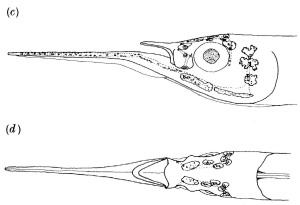Welcome to “Mysteries in Fish Fun ctional Morphology”. From time to time I plan on posting descriptions of some of the most fascinating and perplexing unsolved mysteries in fish functional morphology. My hope is that some of you will find these entertaining, but if you think you might have the answer to any of these mysteries or if you have any comments about them, please feel free to post a comment here. My first installment is the cephalic horn that is found on the forehead of four species of surgeonfish in the genus Naso (N. annulatus, N. brachycentron, N. brevirostris & N. unicornis). The top photo to the left is N. brevirostris (courtesy of Bruce Yates – UnderwaterRelections.com). Below that, a group of N. annulatus. Four species also have a rounded, bump-like protuberance that is less extreme in size and shape (N. tuberosus, N. tonganus, N. mcdadei & N. vlamingii). A picture of N. tonganus illustrating the bump is at the bottom to the left. Remarkably, according to a recent treatment of the phylogenetics of this group (Klanten et al. 2004. Molecular Phylogenetics & Evolution 32:221), the elongate, slender horn appears to have evolved three times among the living species. What is the function of the cephalic horn? One possibility is that the structure is used in mate selection or intrasexual displays – in other words, it evolved as a consequence of sexual selection. For me, this is the by far most appealing hypothesis I have heard, but unfortunately, the structure is not sexually dimorphic, as far as I know. Although this does not rule out the sexual selection hypothesis (sexually selected traits can have equal expression in the two genders), it is a strike against the idea. Nevertheless, Arai & Sato (2007. Ichthyological Research 54:49) observed that the horn of male N. unicornis and the hump of male N. vlamingii were used in quick color-changing displays to females (unicornis) and other males (vlamingii) and these authors favor the sexual selection hypothesis. Many years ago I heard another idea about function – that zooplanton-feeding species use it to help them gauge distance to their prey in the midwater, where there are few positional and distance reference points. This is an interesting idea that has not been tested to my knowledge. But, one complication here is that among the Naso species with the elongate horn, two are benthic herbivores and two feed on plankton and on the benthose. This indicates that a function in plankton feeding is unlikely to explain all occurrences of the structure. So, is this fabulous structure the work of sexual selection or an adaptation for feeding on small plankton in midwater? Or, is there another explanation? What do you think?
ctional Morphology”. From time to time I plan on posting descriptions of some of the most fascinating and perplexing unsolved mysteries in fish functional morphology. My hope is that some of you will find these entertaining, but if you think you might have the answer to any of these mysteries or if you have any comments about them, please feel free to post a comment here. My first installment is the cephalic horn that is found on the forehead of four species of surgeonfish in the genus Naso (N. annulatus, N. brachycentron, N. brevirostris & N. unicornis). The top photo to the left is N. brevirostris (courtesy of Bruce Yates – UnderwaterRelections.com). Below that, a group of N. annulatus. Four species also have a rounded, bump-like protuberance that is less extreme in size and shape (N. tuberosus, N. tonganus, N. mcdadei & N. vlamingii). A picture of N. tonganus illustrating the bump is at the bottom to the left. Remarkably, according to a recent treatment of the phylogenetics of this group (Klanten et al. 2004. Molecular Phylogenetics & Evolution 32:221), the elongate, slender horn appears to have evolved three times among the living species. What is the function of the cephalic horn? One possibility is that the structure is used in mate selection or intrasexual displays – in other words, it evolved as a consequence of sexual selection. For me, this is the by far most appealing hypothesis I have heard, but unfortunately, the structure is not sexually dimorphic, as far as I know. Although this does not rule out the sexual selection hypothesis (sexually selected traits can have equal expression in the two genders), it is a strike against the idea. Nevertheless, Arai & Sato (2007. Ichthyological Research 54:49) observed that the horn of male N. unicornis and the hump of male N. vlamingii were used in quick color-changing displays to females (unicornis) and other males (vlamingii) and these authors favor the sexual selection hypothesis. Many years ago I heard another idea about function – that zooplanton-feeding species use it to help them gauge distance to their prey in the midwater, where there are few positional and distance reference points. This is an interesting idea that has not been tested to my knowledge. But, one complication here is that among the Naso species with the elongate horn, two are benthic herbivores and two feed on plankton and on the benthose. This indicates that a function in plankton feeding is unlikely to explain all occurrences of the structure. So, is this fabulous structure the work of sexual selection or an adaptation for feeding on small plankton in midwater? Or, is there another explanation? What do you think?

 Look at the head and jaws of a halfbeak:
Look at the head and jaws of a halfbeak:

